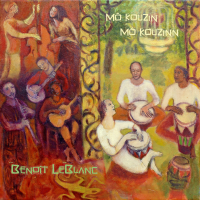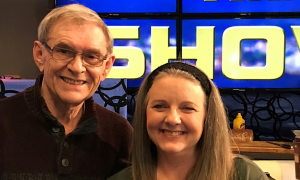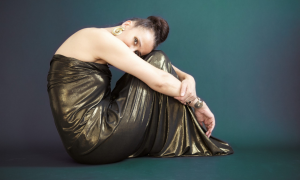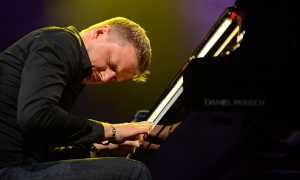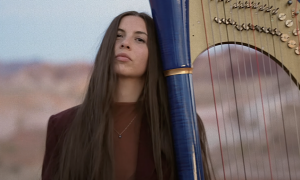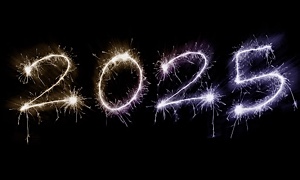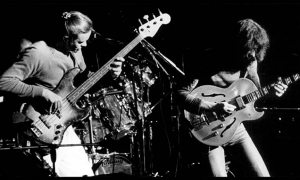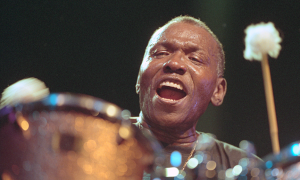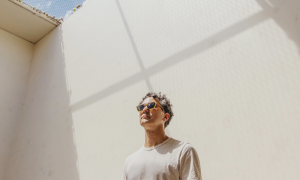Home » Jazz Articles » Interview » Tali Rubinstein: Plastic Art
Tali Rubinstein: Plastic Art

Courtesy Noam Galai
I want to encourage all the [young] musicians out there to try doing things that are not necessarily meant for their instruments, or just to go with their heart and with their ears and what intrigues them. The options are really endless when you erase those borders.
—Tali Rubinstein
"When I was 20, I went to study classical music and math at Tel Aviv University. Until then, I thought I was going to have a career that would combine science and music. But I felt a little out of place in both and wasn't sure [I was on] the right path, so I took a break," said Rubinstein. She eventually enrolled at the Rimon School of Jazz and Contemporary Music in Ramat Hasharon, Israel.
Of course, it is no secret how a talented mathematician would easily translate their comprehension of brain functions to challenging jazz theory concepts. It is rare that any academically invested musician who seriously studies their craft, especially on brass and rhythm instruments, will eventually dabble in jazz. But a recorder player? That's really infrequent.
Most listeners are used to the recorder from elementary school music class. For Rubinstein, the instrument was like a third arm. She explained how she went from being a classical musician and mathematician to falling in love with American music based on swinging rhythms and improvisation over sophisticated harmonies.
"This was supposed to be a year of time off to clear my mind and have fun: learning some jazz, improvising, and playing some groovy music. After that, I was going to go back to studying something serious, whatever that would be. That year changed my perception and opened my mind so much that it completely changed my plans...for the first time, I could imagine a career in music, nothing else. I continued that path and went on to study at Berklee College of Music in Boston. Both Rimon and Berklee gave me a chance to explore a totally foreign musical territory in which I could take risks, create, go to extremes, and discover a new sound. Jazz became my new language."
Humbly, Rubinstein didn't mention that she won a full scholarship to Berklee or that she became the first recorder player accepted to the prestigious music school.
Listening to the music on her website provides a sense of her sound: light tippy-toe rhythms, melodies sung in Hebrew and English, with slightly jazzy vocals and, of course, recorder solos interspersed throughout. There are also impressively produced solo projects, video lessons, other streaming songs, collaborative projects with a full band, and Rubinstein backing the smattering of releases on Javier Limon's Casa Limon America label—including 2013's Promesas De Tierra, which received a Latin GRAMMY for best-engineered album. "Javier was my professor at Berklee, and he invited me to record and arrange for an album he was working on at the time and later on to record a duo album produced by him [Tal y Tali, 2014] with my good friend, pianist/composer Tal Even-Tzur. Since then, I was fortunate to be involved in many projects that Javier produced and to immerse myself in Latin music and specifically in flamenco."
While she finds work doing just about everything a true recorder virtuoso would be tasked with in the industry, Rubinstein says she feels most comfortable, or at least the most interested in, playing jazz. But it's not always easy to find work, especially when you're playing an instrument obscure to a jazz combo. "Two jazz albums I'm very proud to have participated in [and composed for] are Alain Mallet's Mutt Slang (Etrain, 2017) and A Wake of Sorrows Engulfed in Rage (Origin, 2020). Alain was also my teacher at Berklee, and one of the best composers and pianists I've ever met...it was an amazing opportunity to get to be part of these two beautiful albums with so many brilliant musicians."
Rubinstein is experienced in the jazz pedagogy of both Israel and the United States. She doesn't recognize any borders. "I think any form of improvisational music is a way to unite between different cultures, just simply because first of all, it is music, so it is international. You don't have to speak a different language, and the improvisational part of it, exchanging ideas in real time with other people, doesn't necessarily need to be jazz." She compares Israeli jazz to Berklee. "I went to Rimon school...[which]...follows Berklee to a certain extent. It was founded by people who went there...as for the method with which they teach, it's taken from Berklee. There were some differences. Mostly Rimon [is] much [smaller], so [in] the community around it, everyone knew everyone and you had a very close personal relationship with the teachers. Berklee was [also] like that in some of the classes, but it was much bigger, so there is more of a variety, many more options, of course, in English and just to meet people who come from different backgrounds."
Rubinstein actually discovered playing jazz for the first time at Rimon, specifically at her audition. "They ask you to improvise over a jazz tune, so I had to do it...when I started to study at Rimon, I went through all the theory...and I had different teachers and I got to Berklee with a lot of knowledge already and they set me up really well with everything I needed." At Berklee, she took things even further, engaging "not only jazz but many other styles of music, production or composition for film...all of that you can do at Rimon, but just the fact that [Berklee] is bigger and there are more people, different points of view, that was the advantage." In comparing the two music schools, Rubinstein notes that "they complemented each other really nicely, and I am glad that I started in a smaller place, a bit more of a family kind of feeling, and I went to the big city, with all the different people from everywhere."
Rubinstein's music defies the limitations of genre boundaries. "The combination of Israeli music, jazz, and classical music, of course, that's my origins... everything that I've heard since I moved to the U.S. Whenever I'm working on collaborations like these, the other person or people, we both just dive into our own world which is made up of our own personal influences." She brought up her collaborative record with her fellow female Israeli Berklee classmate (and near namesake), pianist Tal Even-Tzur. "Some people would define Tal y Tali like that. Some say it is jazz, some say that it is classical music and some think of it as world music. I wouldn't even know how to categorize it myself. I never really tried to do a proper jazz [album, as in] traditional jazz from the 1930s...and with elements of Israeli music..." Rubinstein elaborated that "I did not try to define a certain style and then make an album to it, I never did [that]."
As for current and future projects and the genres that they will fall into, Rubinstein replies "Now, I am wrapping up an album in Hebrew that I am singing and playing and I don't even know the genre...I think that it is a nice thing to not be able to define the music and have other people define it for themselves, and see what comes out. There's actually another project that I'm getting ready to put out. It's kind of jazz in a way, but it's much more modern. It's a duet of me playing the recorder, and a guy who plays the piano and harpsichord, and some of it simultaneously...it is kind of modern European jazz...but with a recorder and harpsichord, you could say that it is Baroque because of the instrumentation...Some improvised, some sounds like modern classical music."
The conversation then turned to Rubinstein's teaching career. "Nowadays, I'm teaching a lot online, especially since the pandemic started...there's really a lack of good jazz material out there, jazz play-a-longs for recorder...For my students, I just make play-a-longs with some programs that I have. [I was working on a] recorder-specific jazz method book and play-a-long...it's something that I'd be very excited to do, if I find the time to do it, with a real rhythm section playing some heads, solos...and write it out in notes so that students can learn from it."
Not many people in the world play jazz recorder. "All the people who do it know each other, I think, because I can count them on one hand," she said. "There's a guy called Benoit Sauvé. I've seen a lot of his transcriptions of saxophone solos and different classic recordings. I [also] have a good friend whose name is Tobias Reisige. He is a recorder player from Germany...A few years ago he reached out to me and asked me if I would join him for a few shows on a mini-tour in Germany with his band...and that's just a band of recorder, acoustic guitar and upright bass, and they do some jazz, some classical music, Baroque, but some of it is jazz and has an improvisational attitude as well as improvisation when they perform." Despite the small size of the movement, Rubinstein sees hope for the future. "There are some students that are on the way, I think, I hope. At Berklee, for example, you can only study the flute [not the recorder]. There was no option for recorder, there was no teacher; also at Rimon, no recorder teacher..."
When asked about the instrument's history among Europeans and Jews, Rubinstein explained, "It's a Western European instrument, it's the ancestor of the flute, and it kind of faded away, the flute kind of took over...everywhere people play recorder when they're kids, but in Israel there is a little more, especially because on the kibbutz, people would play accordion, recorder and mandolin. For some reason, these instruments because they're able to carry around..." She noted that "Most people play the soprano [recorder], that's the one most people start on, and alto is the second most common. I [also] play sopranino. [And] I [also] have tenor, bass and great bass [recorders]. That's the lowest one that I have, but there are bigger ones than that."
She cites Charlie Parker as one of her biggest influences, noting that she "studied a lot of his solos," as well as John Coltrane and "a lot of saxophone players." She also really likes Chet Baker, "especially his singing and his playing," Thelonious Monk, and mentions her sister, Tammi, with an admiring laugh. She went on to explain that her sister was the "real reason why I started playing jazz. She used to study and she was on the route to become a musician...she played piano and saxophone, and she went to the same high school that I went to. But I went to the classical program and she went to the jazz one. So she was into jazz much before I got into it. I think that influenced me a lot. She also auditioned for Berklee and went to Berklee workshops, but she decided to become a doctor. She had a full scholarship to Berklee and she didn't use it, [laughing] which is amazing to me."
Rubinstein is also a very talented vocalist. She explained that she "prefer[s] singing in Hebrew by far. It's easier for me—not easier— it's more musical for me, either because I don't know whether Hebrew sounds more musical to me or I'm just used to hearing songs in Hebrew...so I associate the syllables and the vowels more easily with music than in English. I feel like when I sing in English, I have to fake it a little bit. I try to make it my own but in Hebrew there are so many associations with the language that it just comes more naturally."
For Rubinstein, the only limits are those that are self imposed : "I want to encourage all the musicians out there to try doing things that are not necessarily meant for their instruments, or just to go with their heart and with their ears and what intrigues them. The options are really endless when you erase those borders."
Tags
Interview
Scott Krane
Tali Rubinstein
Charlie Parker
John Coltrane
recorder
Chet Baker
Benoit Sauv
Tobias Reisige
Israel
Berklee
Rimon
PREVIOUS / NEXT
Support All About Jazz
 All About Jazz has been a pillar of jazz since 1995, championing it as an art form and, more importantly, supporting the musicians who make it. Our enduring commitment has made "AAJ" one of the most culturally important websites of its kind, read by hundreds of thousands of fans, musicians and industry figures every month.
All About Jazz has been a pillar of jazz since 1995, championing it as an art form and, more importantly, supporting the musicians who make it. Our enduring commitment has made "AAJ" one of the most culturally important websites of its kind, read by hundreds of thousands of fans, musicians and industry figures every month.












